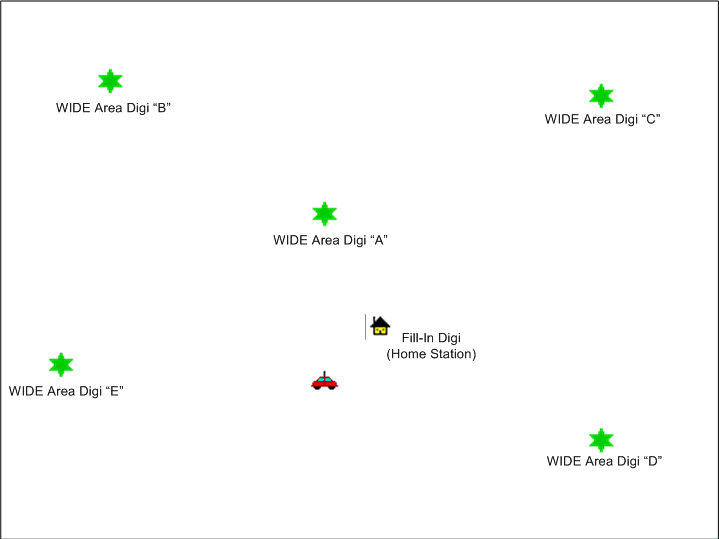“Digipeater” is short for “digital repeater”: a repeater for APRS packet data rather than voice.
Unlike a voice repeater that receives on one frequency and simultaneously retransmits on another frequency, a digipeater is a single frequency device that receives a packet of data, stores it in internal memory, and a moment later retransmits it on the same frequency.
Digpeating is much more critical to APRS than to conventional packet radio, because APRS heavily involves transmission to/from moving vehicles. Traditionally, packet radio was overwhelmingly used between fixed locations with high quality antenna setups. In contrast, moving vehicles have intermittent coverage, limited power, and compromised antenna setups.
Recommended path settings
If you just want to jump ahead to configuring the path settings, please follow these recommendations:
| Situation | Recommended path |
|---|---|
| Urban areas | WIDE1-1, WIDE2-1 Will produce two hops, and take advantage of fill-in digipeaters. |
| Rural areas | WIDE1-1, WIDE2-2 Will produce three hops, two from wide-area digipeaters, and one to take advantage of fill-ins. Use this only in areas with low APRS activity. |
Keep reading for more information on digipeating, including how these path settings work.
Performance
Unlike analogue voice, but like other digital modes, packet radio is sensitive to misconfigured setups. Noisy, scratchy, or clipping audio may prevent successful decoding of the data. A pop, a momentary burst of white noise, flutter, or multipath-induced phase distortion that you don’t even notice on voice may cause an entire packet of data to be lost.
With APRS, the problem of lost data is more prevalent than other protocols (e.g. AX.25 connected mode, TCP, Wi-Fi, etc.) because it operates in a non-connected mode: data broadcasts without retransmissions or acknowledgements. Receiving stations ignore defective packets.
Signals to/from mobile units fluctuate in strength by 15–20 dB as the mobile station moves even a short distance. For reliable data transmission, you must have good signal strength over the intended path. The signal should be enough that even with a 20 dB drop, the signal will remain as noise–free as possible.
Performance also varies with local conditions an weather. For instance, in Melbourne with a 10 watt transmitter and half–wave ground plane antenna, you may get an 80% success rate with your beacons. Meanwhile in Sydney, the success rate may be lower due to the hilly terrain. You may need more power, or a different antenna to increase your success rate in the valleys.
Types of digipeaters
To increase the reliability of transmission from mobiles, APRS uses two categories of digipeaters:
- “WIDE Area” digipeaters placed in strategic locations (mountains, tall buildings, water towers, etc.), similar to the placement one would choose for a voice repeater. WIDE Area digipeaters are generally installed as part of a coordinated approach. This type of digipeater responds to the alias call sign of “WIDEn-N”.
- “Fill-In” digipeaters in areas where mobile stations have poor access to a WIDE Area digipeaters (typically home stations running an APRS client with digipeating enabled). This type traditionally responded to the alias call sign “RELAY” although “RELAY” has been phased out and the alias of “WIDE1-1” is now used.
How paths work
Every APRS packet is prefixed with a “path”, which determines how it is routed. While AX.25 can transmit directly between callsigns (e.g. VK1SRC>VK2DST), most APRS packets are of a broadcast nature, sent “from” a source callsign, “to” a series of generic callsigns that have special meaning.
In this example, the callsign VK1SRC is sending a broadcast for general reception:
VK1SRC>APRSFor digipeating, additional WIDE callsigns are added, which gives a digipeater permission to retransmit the packet, and serves a similar function to the “hop count” in an IP packet.
In this example, WIDE1 represents local “fill-in” digipeaters, WIDE2 represents larger “wide area” digipeaters, and the “-1” or “-2” represents the number of hops for that tier:
VK1SRC>APRS,WIDE1-1,WIDE2-2Each time a packet is relayed, each digipeater in the chain “crosses off” the call sign it responded to (represented in text form by an asterisk (*) after the callsign). This process of “call sign substitution” is unique to APRS, and requires special APRS awareness in TNCs.
The following example shows how the path is transformed as it propagates through digipeaters:
| Situation | Path |
| First, the user VK1SRC transmits a packet with this path: | VK1SRC>APRS,WIDE1-1,WIDE2-2 |
| Next, the “fill-in” digipeater decrements and crosses off WIDE1-1 to WIDE1*: | VK1SRC>APRS,WIDE1*,WIDE2-2 |
| Then, “wide area” digipeater DIGIA decrements WIDE2-2 to WIDE2-1, and inserts its own crossed off callsign: | VK1SRC>APRS,WIDE1*,DIGIA*,WIDE2-1 |
| Finally, any remaining “wide area” digipeaters within range relay the packet for the last time: | VK1SRC>APRS,WIDE1*,DIGIA*,DIGIB*,WIDE2* VK1SRC>APRS,WIDE1*,DIGIA*,DIGIC*,WIDE2* VK1SRC>APRS,WIDE1*,DIGIA*,DIGID*,WIDE2* VK1SRC>APRS,WIDE1*,DIGIA*,DIGIE*,WIDE2* |
This is illustrated in the following graphic:

A transmitted packet may be received by other stations listening on RF; be digipeated multiple times; or be received by an I-Gate that relays the packet into the APRS Internet Service (APRS-IS).
Limiting the number of digipeaters (e.g. by choosing “WIDE2-1” instead of “WIDE2-2”) will reduce the number of unnecessary relays, and increase the available RF bandwidth for everyone.
For most use cases, digipeating just enough times to get to an I-Gate that relays to/from the APRS-IS network is sufficient.